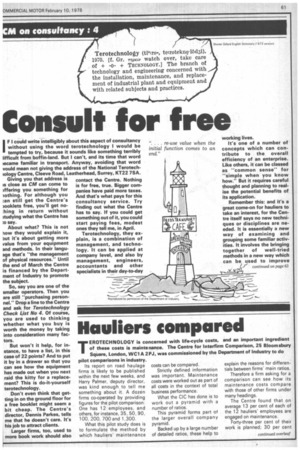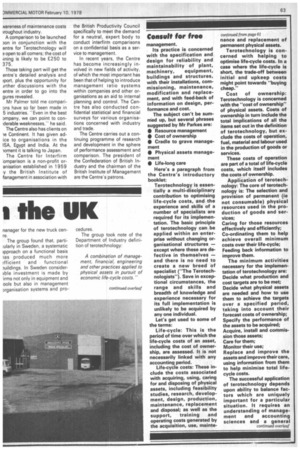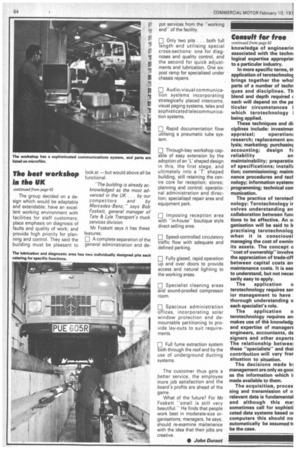Consult for free
Page 63

Page 65

Page 66

If you've noticed an error in this article please click here to report it so we can fix it.
IF I could write intelligibly about this aspect of consultancy without using the word terotechnology I would be tempted to try, because it sounds like something terribly lifficult from boffin-land. But I can't, and its time that word oecame familiar in transport. Anyway, avoiding that word
About what? This is not how they would explain it, but it's about getting more value from your equipment and methods. In their language that's "the management of physical resources." Until the end of March the Centre is financed by the Department of Industry to promote the subject.
So, say you are one of the smaller operators. Then you are still "purchasing personnel." Drop a line to the Centre and ask for Terotechnology Check List No 4. Of course, you are used to thinking whether what you buy is worth the money by taking into consideration many factors.
But won't it help, for instance, to have a list, in this case of 22 points? And to put it by in a drawer so that you can see how the equipment has made out when you next raid the kitty for a replacement? This is do-it-yourself terotechnology.
Don't even think that getting in on the ground floor for a free booklet might seem a bit cheap. The Centre's director, Dennis Parkes, tells me that he doesn't care. It's his job to attract clients.
Larger firms, too, used to more book work should also contact the Centre. Nothing is for free, true. Bigger companies have paid more taxes. And that's what pays for this consultancy service. Try finding out what the Centre has to say. If you could get something out of it, you could start paying fees, modest ones they tell me, in April.
Terotechnology, they explain, is a combination of management, and technology. It can be applied at company level, and also by management, engineers, accountants and other specialists in their day-to-day working lives.
It's one of a number of concepts which can contribute to the overall efficiency of an enterprise. Like others, it can be classed as "common sense" for "simple when you know how." But it requires careful thought and planning to realise the potential benefits of its application.
Remember this: and it's a great come-on for hauliers to take an interest, for the Centre itself says no new techniques or disciplines are needed. It is essentially a new way of examining and grouping some familiar activities. It involves the bringing together of well-tried methods in a new way which can be used to improve Its practice is concerned with the specification and design for reliability and maintainability of plant, machinery, equipment, buildings and structures, with their installations, commissioning, maintenance, modification and replacement, and with feed-back of information on design, performance and cost.
The subject can't be summed up, but several phrases suggested by Mr Parkes are: • Resource management • Cost of ownership • Cradle to grave management • Physical assets management • Life-long care Here's a paragraph from the Centre's introductory booklet: Terotechnology is essentially a multi-disciplinary contribution to optimising life-cycle costs, and the experience and skills of a number of specialists are required for its implementation. The basic principle of terotechnology can be applied within an enterprise without changing organisational structures — except where these are defective in themselves — and there is no need to create a new breed of specialist ("The Terotechnologists"). Save in exceptional circumstances, the range and skills and breadth of knowledge and experience necessary for its full implementation is unlikely to be acquired by any one individual.
Let's get used to some of the terms: Life-cycle: This is the period of time over which the life-cycle costs of an asset, including the cost of ownership, are assessed. It is not necessarily linked with any accounting period.
Life-cycle costs: These include the costs associated with acquiring, using, caring for and disposing of physical assets, including feasibility studies, research, development, design, production, maintenance, replacement and disposal; as well as the support, training and operating costs generated by the acquisition, use, mainte
conanued from page 61
nance and replacement of permanent physical assets.
Terotechnology is concerned with helping to optimise life-cycle costs. In a case where the life-cycle is short, the trade-off between initial and upkeep costs might point towards "buying cheap."
Cost of ownership: Terotechnology is concerned with the "cost of ownership" of physical assets. Costs of ownership in turn include the total implications of all the items set out in the definition of terotechnology, but exclude the costs of operation, fuel, material and labour used in the production of goods or services.
These costs of operation are part of a total of life-cycle costs, which itself includes the costs of ownership.
Application of terotechnology: The core of terotechnology is: The selection and provision of permanent (ie not consumable) physical resources used in the production of goods and services; Caring for those resources effectively and efficiently; Co-ordinating them to help achieve overall minimum costs over their life-cycle; Feeding back information to improve them.
The minimum activities necessary for the implementation of terotechnology are: Decide what production and cost targets are to be met; Decide what physical assets are needed and how to use them to achieve the targets over a specified period, taking into account their forecast costs of ownership; Specify the performance of the assets to be acquired; Acquire, install and commission those assets; Care for them; Monitor their use; Replace and improve the assets and improve their care, using information from them to help minimise total lifecycle costs.
The successful application of terotechnology depends upon ability to balance factors which are uniquely important for a particular situation. It requires an understanding of management and accounting sciences and a general knowledge of engineerin associated with the techno logical expertise appropriai to a particular industry.
In more specific terms, th application of terotechnolog brings together the whol parts of a number of techn ques and disciplines. Th blend and depth required ( each will depend on the pa ticular circumstances i which terotechnology i being applied.
These techniques and di: ciplines include: investmer appraisal; operation; research; replacement an( lysis; marketing; purchasinf accounting; design fc reliability an maintainability; preparatio of specifications; install( tion; commissioning; mainti nance procedures and tect nology; information system; programming; technical con munication.
The practice of terotect nology: Terotechnology ir volves understanding an collaboration between fun( tions to be effective. An oi ganisation will be said to b practising terotechnolog when it is consciousl managing the cost of ownin its assets. The concept o "cost of ownership" involve the appreciation of trade-off between capital costs an maintenance costs. It is eas to understand, but not neces sarily easy to apply.
The application o terotechnology requires ser ior management to have thorough understanding o each specialist's role.
The application terotechnology requires arm makes use of the knovviedg and expertise of managers engineers, accountants, de signers and other experts The relationship betweel these "specialists" and thei contribution will vary fror situation to situation.
The decisions made 1)1 management are only as goo( as the information which made available to them.
The acquisition, proces sing and transmission of o relevant data is fundamental and although this mal sometimes call for sophisti cated data systems based ol computers this should no automatically be assumed t( be the case.












































































































